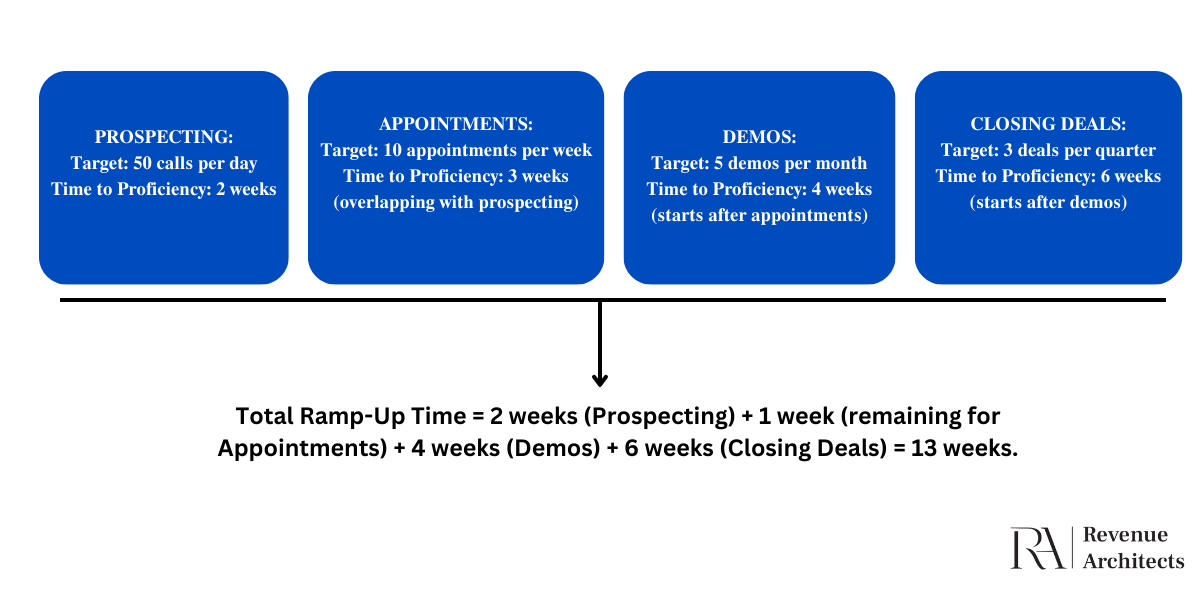The sales ramp-up period refers to the time it takes for a new sales representative to reach full productivity from the moment of being hired. It is important for companies to accurately calculate this period in order to manage costs and resources effectively. Understanding the length of the sales ramp-up time enables executives to make better forecasts and allocate resources appropriately. It also helps in setting realistic sales targets and expectations, ensuring that sales teams are neither underperforming nor overburdened.
Having a clear understanding of ramp-up time enables companies to design training programs that can speed up productivity, leading to increased revenue and a more efficient onboarding process. This insight also helps in identifying potential bottlenecks and areas for improvement in the sales training and integration process, which in turn leads to continuous optimization and growth.
In this article, we will outline three different methods for easily calculating your sales ramp-up period. You can select the one that best fits your organization, but it’s important to remember that you are dealing with individual people and that everyone is different. Statistics provide guidelines, but they are not always entirely accurate and you should be involved in this process by HR managers to help you make better decisions.
1. Calculating Sales Ramp-up by the length of the sales cycle
The simplest way to calculate the amount of time required to train a professional salesperson for your company is by using the length of your sales cycle. Suppose you already have a salesperson who has experience with clients similar to yours. In that case, you can calculate the ramp-up time by adding buffer time to your sales cycle time. This buffer time accounts for the onboarding process, during which the new hire becomes acquainted with your company’s fundamental principles. If the individual is new to sales or a recent graduate, additional time should be factored into your calculation.
For example, if your sales cycle is 30 days and the buffer time for onboarding activities is two weeks, an experienced professional would be fully operational in about a month and a half. In contrast, someone new to the industry might require more than three months to reach the same level of readiness.

2. Calculating Sales Ramp-up by the time needed to reach the quota
This method is known as the quota attainment method as well, and it is widely used to calculate ramp-up time. It involves measuring the average time it takes for a salesperson to reach 100% of their sales targets or quotas. This method is popular because it acknowledges that sales reps do not all start from the same position. Some may leverage their previous contacts and experience to reach their quota faster than newcomers.
To calculate ramp-up time using quota attainment:
- Set Clear Quotas: Define specific, measurable sales targets for your sales reps. This provides a clear goal for new hires to achieve.
- Track Progress: Monitor the performance of sales reps over time, noting how long it takes each individual to reach their set quotas.
- Analyze Data: Calculate the average time taken by all sales reps to reach their quotas. This average provides a benchmark for expected ramp-up time.
TIP: During onboarding and the ramp-up period, consider using a draw against commission to balance wages. This approach provides new sales reps with a guaranteed income that offsets the lack of incentive payments while they are still getting up to speed. This can help maintain motivation and financial stability during the critical early months.
3. Calculating Sales Ramp-up by the training and experience level
Now that you are familiar with the previous two methods, this one is straightforward. Simply add the average amount of time required to train a new sales hire to your average sales cycle. Once that is calculated, include the expected ramp-up time based on the new hire’s level of experience.
By tailoring your training approach according to the experience of the new hire, you can expedite the ramp-up process for those with more experience while providing adequate time for less experienced sales reps to adjust and learn. This method ensures that each salesperson receives the appropriate level of support and training necessary to reach full productivity efficiently
4. Calculating Sales Ramp-up by the Activity Metrics
To calculate ramp-up time by activity metrics (from your CRM software), you need to break down the sales process into specific activities and measure the time it takes for a new sales representative to become proficient in each activity. To do this, you should identify key sales activities for your business, such as making calls, setting appointments, conducting demos, and closing deals. Next, set benchmarks for each activity, such as the number of calls per day or the number of demos per month. Then, track the time it takes for your new sales rep to meet or exceed these benchmarks and analyze the data to determine the total ramp-up time.
This calculation ensures that new hires are meeting specific performance benchmarks and allows you to pinpoint areas where additional training might be needed. This method helps create a clear, measurable path to full productivity for new sales reps.
Here is an example calculation:

Conclusion
Understanding and applying methods such as evaluating the length of your sales cycle, assessing quota attainment, evaluating training and experience levels, and analyzing activity metrics, can help in creating a structured and efficient onboarding process tailored to the experience level of each new hire. However, if you have never done it before, this can be difficult to calculate and assess without someone with experience working with sales professionals. Not to worry, our expert sales coaches Mario Krivokapic and Noam Tamari-Wekser are just a click away from you. Start your business’ new chapter by contacting them via a simple form.

